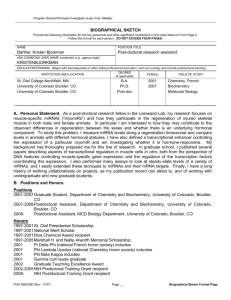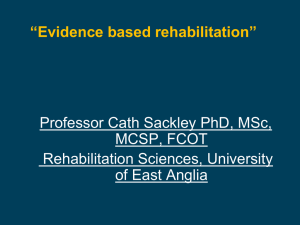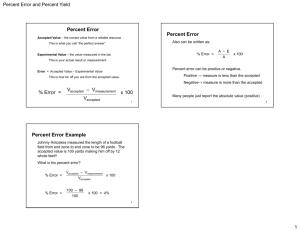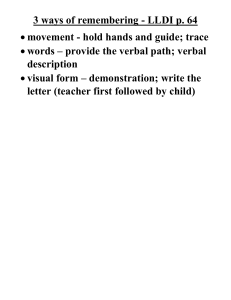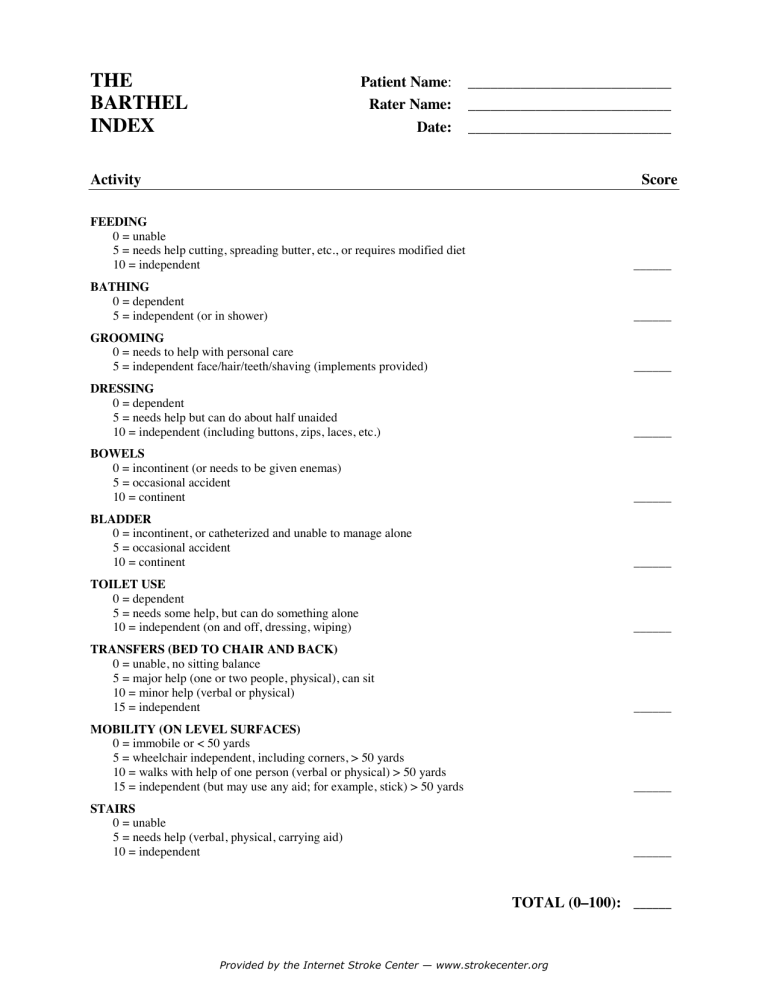
THE BARTHEL INDEX Patient Name: Rater Name: Date: ___________________________ ___________________________ ___________________________ Activity Score FEEDING 0 = unable 5 = needs help cutting, spreading butter, etc., or requires modified diet 10 = independent ______ BATHING 0 = dependent 5 = independent (or in shower) ______ GROOMING 0 = needs to help with personal care 5 = independent face/hair/teeth/shaving (implements provided) ______ DRESSING 0 = dependent 5 = needs help but can do about half unaided 10 = independent (including buttons, zips, laces, etc.) ______ BOWELS 0 = incontinent (or needs to be given enemas) 5 = occasional accident 10 = continent ______ BLADDER 0 = incontinent, or catheterized and unable to manage alone 5 = occasional accident 10 = continent ______ TOILET USE 0 = dependent 5 = needs some help, but can do something alone 10 = independent (on and off, dressing, wiping) ______ TRANSFERS (BED TO CHAIR AND BACK) 0 = unable, no sitting balance 5 = major help (one or two people, physical), can sit 10 = minor help (verbal or physical) 15 = independent ______ MOBILITY (ON LEVEL SURFACES) 0 = immobile or < 50 yards 5 = wheelchair independent, including corners, > 50 yards 10 = walks with help of one person (verbal or physical) > 50 yards 15 = independent (but may use any aid; for example, stick) > 50 yards ______ STAIRS 0 = unable 5 = needs help (verbal, physical, carrying aid) 10 = independent ______ TOTAL (0–100): ______ Provided by the Internet Stroke Center — www.strokecenter.org The Barthel ADL Index: Guidelines 1. 2. 3. 4. 5. 6. 7. The index should be used as a record of what a patient does, not as a record of what a patient could do. The main aim is to establish degree of independence from any help, physical or verbal, however minor and for whatever reason. The need for supervision renders the patient not independent. A patient's performance should be established using the best available evidence. Asking the patient, friends/relatives and nurses are the usual sources, but direct observation and common sense are also important. However direct testing is not needed. Usually the patient's performance over the preceding 24-48 hours is important, but occasionally longer periods will be relevant. Middle categories imply that the patient supplies over 50 per cent of the effort. Use of aids to be independent is allowed. References Mahoney FI, Barthel D. “Functional evaluation: the Barthel Index.” Maryland State Medical Journal 1965;14:56-61. Used with permission. Loewen SC, Anderson BA. “Predictors of stroke outcome using objective measurement scales.” Stroke. 1990;21:78-81. Gresham GE, Phillips TF, Labi ML. “ADL status in stroke: relative merits of three standard indexes.” Arch Phys Med Rehabil. 1980;61:355-358. Collin C, Wade DT, Davies S, Horne V. “The Barthel ADL Index: a reliability study.” Int Disability Study.1988;10:61-63. Copyright Information The Maryland State Medical Society holds the copyright for the Barthel Index. It may be used freely for noncommercial purposes with the following citation: Mahoney FI, Barthel D. “Functional evaluation: the Barthel Index.” Maryland State Med Journal 1965;14:56-61. Used with permission. Permission is required to modify the Barthel Index or to use it for commercial purposes. Provided by the Internet Stroke Center — www.strokecenter.org

